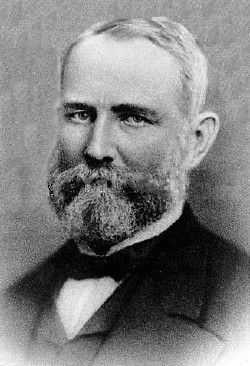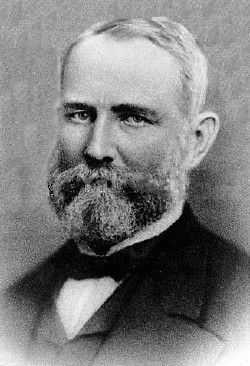The Evening Star Friday, May 17, 1889
Georgetown
To Be Buried Here
The remains of General Adna Anderson, of New York, who shot himself at the Lafayette Hotel, in Philadelphia, late Tuesday night, will be brought to this city and funeral services will take place in the chapel at Oak Hill Cemetery tomorrow.
The Helena Daily Herald
Thursday, May 16, 1889
General Anderson
Short Sketch of the Life of a Remarkable Man, Who Ended His Career Yesterday by Suicide
A private telegram received in Helena yesterday afternoon announced the death in Philadelphia of General Adna Anderson, ex-Chief Engineer of the Northern Pacific Railroad. The sad news was published in the Herald yesterday afternoon and last night it was supplemented by the startling announcement, flashed over the wires in a press dispatch, that General Anderson had committed suicide. What the motive was that prompted the rash act is not known. All that can be learned of the tragedy is reported in our telegraphic columns today.
The deceased was one of the most remarkable railway men of the age and was well known in Montana where he superintended the construction of the Northern Pacific Railroad. He was born in Ridgeway, Orleans County, New York, July 25th, 1827. He entered railroad life in 1847, acting as chain man on a surveying party for the location of the New York and New Haven Railroad. He soon rose in his profession and in 1848 was Assistant Engineer of the Connecticut River Railroad in Massachusetts, occupying similar positions on several other roads. In 1860 he became Chief Engineer of the Henderson & Nashville Railroad. From June 1862 to February 1863, he was Assistant Engineer and Chief of the Construction Corps of the Army of the Potomac in Virginia and afterwards Chief Engineer of military roads in that State. From February to November 1864, he was General Superintendent of government roads, military Division of Mississippi; from November 1864 to July 1866, Chief Superintendent and Engineer of the military roads of the United States. After the war he was Chief Engineer of the Illinois & St. Louis Bridge; General Superintendent of the Kansas Pacific Railroad for three years; Vice President and General Manager of the Toledo, Wabash & Western Railroad for three years; Vice President and afterwards President of the Lafayette and Bloomington Railroad Co.; receiver of the Chicago, Danville and Vincennes Railroad; General Manager of the Paducah and Elizabethtown Railroad and from February 1880 to January 1888 Chief Engineer of the Northern Pacific Railroad and from October 1886 to January 1888 second Vice President of the same company.
General Anderson was a warm personal friend of Colonel and Mrs. W.F. Sanders, of this city. Colonel Sanders was grieved at the news and when asked by a reporter what he knew of the deceased, he said: Prior to the war, in Tennessee and when the war broke out, General Anderson was in charge of a railroad running out of Nashville and was appointed receiver of the road by Governor Isham G. Harris, who is today United States Senator. Governor Harris was importuned to take the road away from him because he was a Yankee. The Governor replied that Anderson was an honest man and as the only reason advanced for his removal was his birthplace, he refused to remove him and kept him in possession of the railroad. Anderson was in Tennessee when the war broke out in 1861 and while his sympathies were on the Union side, he was not demonstrative. When Fort Donelson fell and Buell’s army came down from Bowling Green to Nashville, Anderson was on the river and first saw the troops coming down the pass. Subsequently he moved to Virginia and was made Superintendent of all military transportation under General Grant.
He was a man of remarkable ability, continued Colonel Sanders, and fit to be President of the United States or any other position that could be accorded him. He was a great man and understood better than any man I ever knew, excepting General Grant, the power of silence; he was wonderful in this, but to his acquaintances he was genial and interesting.
His monument is not only his patriotism which was preponderable in force, but the Northern Pacific Railroad, which he built and laid from Bismarck to Tacoma; it is his own creation more than any other man’s.
General Anderson leaves a wife and three children, two boys and a girl. One of his daughters is the wife of Lieut. Fremont, of the United States Army, a son of General John C. Fremont. At the time of his death General Anderson was President of the Steel Car Company and President of a burglar alarm company. While he always commanded a princely salary during his life, having received $17,000 a year from the Northern Pacific Company, it is believed he died a comparatively poor man.
The Evening Star Friday, May 17, 1889
Georgetown
To Be Buried Here
The remains of General Adna Anderson, of New York, who shot himself at the Lafayette Hotel, in Philadelphia, late Tuesday night, will be brought to this city and funeral services will take place in the chapel at Oak Hill Cemetery tomorrow.
The Helena Daily Herald
Thursday, May 16, 1889
General Anderson
Short Sketch of the Life of a Remarkable Man, Who Ended His Career Yesterday by Suicide
A private telegram received in Helena yesterday afternoon announced the death in Philadelphia of General Adna Anderson, ex-Chief Engineer of the Northern Pacific Railroad. The sad news was published in the Herald yesterday afternoon and last night it was supplemented by the startling announcement, flashed over the wires in a press dispatch, that General Anderson had committed suicide. What the motive was that prompted the rash act is not known. All that can be learned of the tragedy is reported in our telegraphic columns today.
The deceased was one of the most remarkable railway men of the age and was well known in Montana where he superintended the construction of the Northern Pacific Railroad. He was born in Ridgeway, Orleans County, New York, July 25th, 1827. He entered railroad life in 1847, acting as chain man on a surveying party for the location of the New York and New Haven Railroad. He soon rose in his profession and in 1848 was Assistant Engineer of the Connecticut River Railroad in Massachusetts, occupying similar positions on several other roads. In 1860 he became Chief Engineer of the Henderson & Nashville Railroad. From June 1862 to February 1863, he was Assistant Engineer and Chief of the Construction Corps of the Army of the Potomac in Virginia and afterwards Chief Engineer of military roads in that State. From February to November 1864, he was General Superintendent of government roads, military Division of Mississippi; from November 1864 to July 1866, Chief Superintendent and Engineer of the military roads of the United States. After the war he was Chief Engineer of the Illinois & St. Louis Bridge; General Superintendent of the Kansas Pacific Railroad for three years; Vice President and General Manager of the Toledo, Wabash & Western Railroad for three years; Vice President and afterwards President of the Lafayette and Bloomington Railroad Co.; receiver of the Chicago, Danville and Vincennes Railroad; General Manager of the Paducah and Elizabethtown Railroad and from February 1880 to January 1888 Chief Engineer of the Northern Pacific Railroad and from October 1886 to January 1888 second Vice President of the same company.
General Anderson was a warm personal friend of Colonel and Mrs. W.F. Sanders, of this city. Colonel Sanders was grieved at the news and when asked by a reporter what he knew of the deceased, he said: Prior to the war, in Tennessee and when the war broke out, General Anderson was in charge of a railroad running out of Nashville and was appointed receiver of the road by Governor Isham G. Harris, who is today United States Senator. Governor Harris was importuned to take the road away from him because he was a Yankee. The Governor replied that Anderson was an honest man and as the only reason advanced for his removal was his birthplace, he refused to remove him and kept him in possession of the railroad. Anderson was in Tennessee when the war broke out in 1861 and while his sympathies were on the Union side, he was not demonstrative. When Fort Donelson fell and Buell’s army came down from Bowling Green to Nashville, Anderson was on the river and first saw the troops coming down the pass. Subsequently he moved to Virginia and was made Superintendent of all military transportation under General Grant.
He was a man of remarkable ability, continued Colonel Sanders, and fit to be President of the United States or any other position that could be accorded him. He was a great man and understood better than any man I ever knew, excepting General Grant, the power of silence; he was wonderful in this, but to his acquaintances he was genial and interesting.
His monument is not only his patriotism which was preponderable in force, but the Northern Pacific Railroad, which he built and laid from Bismarck to Tacoma; it is his own creation more than any other man’s.
General Anderson leaves a wife and three children, two boys and a girl. One of his daughters is the wife of Lieut. Fremont, of the United States Army, a son of General John C. Fremont. At the time of his death General Anderson was President of the Steel Car Company and President of a burglar alarm company. While he always commanded a princely salary during his life, having received $17,000 a year from the Northern Pacific Company, it is believed he died a comparatively poor man.
Family Members
Advertisement
Advertisement










